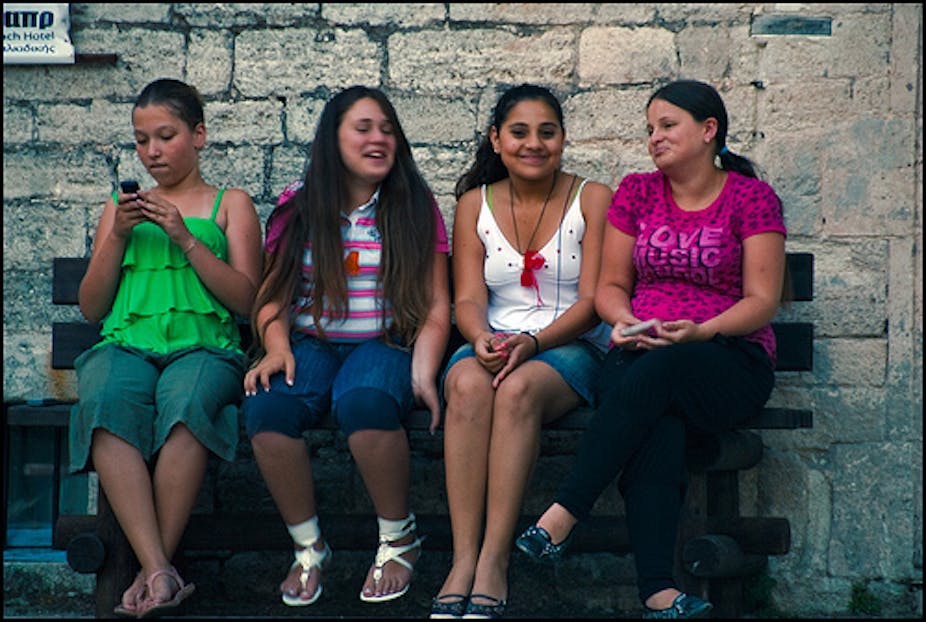You just have to turn on the television or catch a glimpse of a magazine newsstand to see how girls are being thrust into adulthood earlier and earlier. But does biology match societal change? Are girls beginning puberty and maturing at an earlier age?
Puberty is a complex biological process involving rising levels of sex hormones, driven by louder and stronger trigger pulses from the brain. In girls, the process culminates in the release of an egg from the girl’s ovary, signalling the body’s readiness to reproduce.
Research over the past 20 years has suggested girls are reaching puberty at an earlier age. But while it’s true that girls are experiencing some pubertal changes earlier on – developing breasts, for instance – the actual age they get their first period (menarche) has actually stabilised at around 13 years.
Changes in puberty onset
Peter Gluckman and Mark Hanson, evolutionary biologists from New Zealand and the United Kingdom, suggest the age girls achieve puberty has fluctuated markedly throughout history, likely reflecting societal change and the human body’s ability to adapt.
Their theory goes as follows:
More than 20,000 years ago, in small hunter-gatherer societies, scientists estimate the age range of menarche was similar to what it is now, between seven and 13 years.
At the start of agricultural settlement 2,000 years ago, the age of menarche increased. Girls weren’t able to reproduce until they were a few years older, around 15 years of age.
During the industrial revolution, the average age of menarche increased to 16-17 years, likely a result of overcrowding and poor childhood nutrition and hygiene.
In the nineteenth and early 20th centuries, we saw a marked decrease in the age of puberty, largely due to better nutrition, hygiene and health.
Over the last 100 years, studies have shown the age of puberty has varied, even decade to decade, with girls from the United Kingdom, Canada and the United States born in the 1960s reporting the oldest age of puberty onset, at 13.37 years.
Contributing factors
Many internal and external factors play a part in the changing age of puberty onset, including genes and ethnicity. From a biological point of view, the exact “triggers” for puberty are still unknown but it’s widely accepted that nutrition is the greatest factor.
Studies have shown that girls begin puperty at an earlier age if they moved from a developing country – where nutritional food may be limited – to a developed country. The body needs to be assured it has adequate fat mass to enter the reproductive phase – it’s basically the human body’s way of saying “I am ready”.
As we entered the 21st century, we managed to overtake the struggle for adequate nutrition with a new challenge: obesity, which promotes earlier pubertal development, such as breast tissue development.
Other factors that affect early puberty include excessive stress. Studies have shown that “stress” in the womb (such as nutritional deficits), as well biological or psychological stress in childhood, can alter the hormone levels in the body and, in some cases, promote earlier sexual development.
Worryingly, increasing levels of synthetic oestrogens in our environment is another trigger for earlier puberty onset. Oestrogen is more widely available in our 21st century environment and synthetic oestrogens are used in plastic water bottles and food packaging containing the compound BPA.
Oestrogen also occurs naturally in foods such as soy milk and is present in commonly-used pesticides.
But while animal studies have found significant reproductive changes associated with these external oestrogens, the level of impact on the human body is yet to be fully realised, in part due to the difficulty in studying this effect in isolation.
Impact of earlier age puberty
As girls reach puberty, their physical development may not be matched by psychological development and an increased sexual awareness.
Young girls may feel pressure to have sexual relationships at an earlier age, before they’ve developed their own values or the confidence to negotiate sexual relationships.
Puberty can bring issues of body image and self esteem to the fore – the media is guilty of capitalising on this. Sexualised programming targets increasingly younger audiences and plays a big role in the precocious development of girls. Just look as show such as Toddlers and Tiaras.
Regardless of the causes of early puberty, it’s clear our landscape is changing and our bodies are evolving or adapting to meet it. The question – or challenge – is whether young minds can keep up with the rate their bodies are developing.


